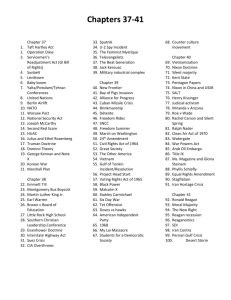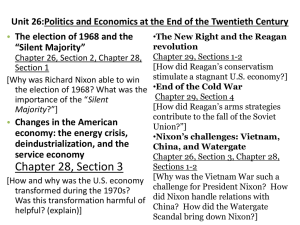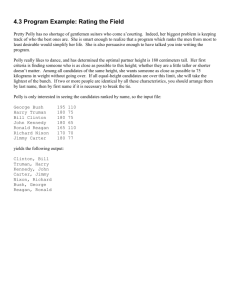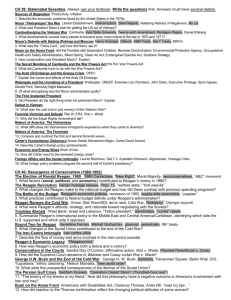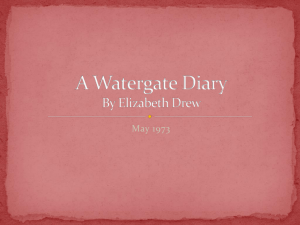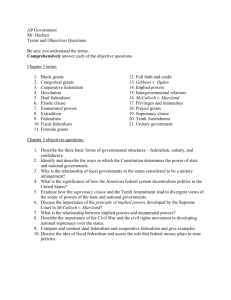Caldwell 1 Stephen Caldwell Professor Gormley PPOL
advertisement
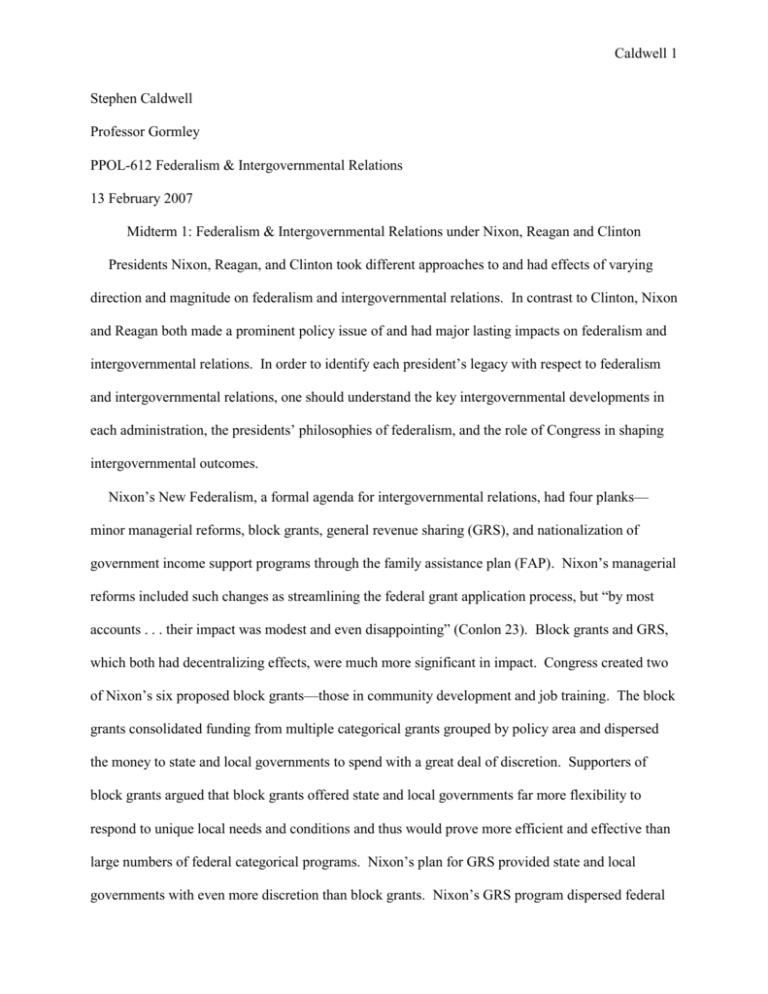
Caldwell 1 Stephen Caldwell Professor Gormley PPOL-612 Federalism & Intergovernmental Relations 13 February 2007 Midterm 1: Federalism & Intergovernmental Relations under Nixon, Reagan and Clinton Presidents Nixon, Reagan, and Clinton took different approaches to and had effects of varying direction and magnitude on federalism and intergovernmental relations. In contrast to Clinton, Nixon and Reagan both made a prominent policy issue of and had major lasting impacts on federalism and intergovernmental relations. In order to identify each president’s legacy with respect to federalism and intergovernmental relations, one should understand the key intergovernmental developments in each administration, the presidents’ philosophies of federalism, and the role of Congress in shaping intergovernmental outcomes. Nixon’s New Federalism, a formal agenda for intergovernmental relations, had four planks— minor managerial reforms, block grants, general revenue sharing (GRS), and nationalization of government income support programs through the family assistance plan (FAP). Nixon’s managerial reforms included such changes as streamlining the federal grant application process, but “by most accounts . . . their impact was modest and even disappointing” (Conlon 23). Block grants and GRS, which both had decentralizing effects, were much more significant in impact. Congress created two of Nixon’s six proposed block grants—those in community development and job training. The block grants consolidated funding from multiple categorical grants grouped by policy area and dispersed the money to state and local governments to spend with a great deal of discretion. Supporters of block grants argued that block grants offered state and local governments far more flexibility to respond to unique local needs and conditions and thus would prove more efficient and effective than large numbers of federal categorical programs. Nixon’s plan for GRS provided state and local governments with even more discretion than block grants. Nixon’s GRS program dispersed federal Caldwell 2 tax revenue to state and local governments and “annually provided more than $6.1 billion in 'no strings' grants to virtually all general-purpose governments in the United States” (Conlon 65). Nixon failed to nationalize the income support programs, as explained below. One must not only look at the effect of Nixon’s New Federalism agenda but also at the regulatory changes that occurred during his administration. Despite the decentralizing effect of block grants and GRS, the “Nixon administration presided over and contributed to the greatest expansion of federal regulation of state and local governments up until that point in American history” (Conlon 85). For example, under Nixon the federal government made transportation funds contingent upon states’ adoption of the national minimum speed limit of 55 miles per hour. In addition, Nixon oversaw the creation of costly federal environmental regulations, such as national emissions standards for air pollution. Moreover, “because block grants and GRS brought federal aid to many communities for the first time, the New Federalism actually became the vehicle for carrying federal influence more deeply into American society than ever before” (Conlon 87). Nixon’s successes and failures in enacting his New Federalism agenda stemmed from the different reactions his proposals received in Congress. As Conlon explains, Nixon’s New Federalism proposals constituted a coherent policy agenda; however, Nixon “faced a highly fragmented and complicated political system—especially in Congress” (15). Congress’s reaction to Nixon’s proposals stemmed from members’ electoral considerations, concerns over Congressional turf, interest group pressure, and ideology. Congress only passed two of the six block grants suggested by Nixon, and many Congressmen opposed GRS. Congressmen opposed block grants in part because they resented relinquishing control over categorical grants, since the “particularized benefits” from the programs such grants funded gave Congressmen valuable opportunities for credit claiming, advertising, and casework with their constituents (Conlon 41). Importantly, the interest groups that supported categorical programs and the federal bureaucrats that ran such programs actively worked to turn powerful committee and Caldwell 3 subcommittee members against block grants. The two block grants that Congress did pass, for community development and job training, enjoyed support from the consolidated programs’ constituents—mainly state and local governments—who recognized that categorical programs did not perform well. Moreover, Conlon argues that in the case of these two difficult policy areas, Congressmen may have been eager to avoid blame for poor performing categorical grant programs (63). Nixon’s GRS and FAP proposals met with different receptions in Congress. Fiscal conservatives opposed block grants and GRS out of concern that they would prove wasteful. While committee and subcommittee chairmen tended to oppose GRS out of concern over important turf, Congress passed GRS largely owing to the support of junior Congressmen who had less control to lose over grants and more to fear from state and local governments lobbying for GRS. Nixon’s FAP proposal stalled in the Senate, caught between conservative southerners who feared its national income floor was too high and northern liberals who feared the floor was too low. Nixon promoted his New Federalism agenda as his most important domestic policy priority. Nixon’s New Federalism comprised a coherent set of policies intended to, in the president’s own words, “make government more effective as well as more efficient.” Nixon did not reject the expanded role of government and the government activism of the New Deal and the Great Society, rather he sought to rationalize the responsibilities of the federal, state, and local governments. As Conlon notes, generally accepted principles of public administration and public finance underlay Nixon’s New Federalism (301). Nixon sought to grant increased autonomy and authority to state and local governments in policy areas where they would be most effective and efficient and to expand the role of the national government in the policy areas he deemed appropriate, such as income redistribution, where public finance argues the federal government is more efficient. Comparing Nixon’s idea of federalism to Wright’s models of intergovernmental relations, one can see a resemblance to Wright’s overlapping-authority model. Nixon’s use of block grants and GRS to Caldwell 4 allow for state and local flexibility while also requiring that they follow federal guidelines demonstrates the intergovernmental bargaining described by Wright. In contrast to Nixon, Reagan emphasized a more radical form of federalism—one with a heavy emphasis on states’ rights and a disparaging view of the federal government—in his rhetoric, saying “it is my intention to curb the size and influence of the Federal establishment and to demand recognition of the distinction between powers granted to the Federal government and those reserved to the states.” According to Conlon, however, “federalism reform per se was not among [Reagan’s] ultimate policy objectives,” but rather one that Reagan embraced primarily as a matter of expedience (109). Reagan wanted to drastically reduce the size of government at all levels and to remove the federal government from many policy areas entirely. In addition, Reagan promoted his vision of the free market and conservative social values. Since the federalist goals of decentralization and deregulation often coincided with Reagan’s objectives, he supported them. For example, in passing responsibility from the federal government to state governments, Reagan could simultaneously reduce the overall size of government. However, Reagan did not shy away from increasing federal regulation and exerting federal power over state and local governments when it served his goals of promoting the free market or conservative social values. As noted above, Reagan did not act in accord with a consistent philosophy of federalism. Nonetheless, one can see parallels between Reagan’s idea of federalism and the coordinate model defined by Wright insofar as Reagan envisioned a radically limited role for the federal government in all areas—save for national defense—with responsibilities shifted to state and local government and, ideally, ultimately the private market and voluntary associations. Reagan’s federalism agenda included reductions in intergovernmental aid, new block grants, the termination of GRS, regulatory relief, tax reform, and a grand “swap” of federal responsibility for Medicaid in return for state responsibility for welfare. However, Reagan never achieved sufficient support to even propose his grand “swap” to Congress. In addition, Reagan’s Supreme Court Caldwell 5 appointments and new regulations enacted during his terms had lasting impacts on federalism and intergovernmental relations. Reagan did succeed in decentralizing power through block grants and, to some extent, regulatory relief. In 1981, Reagan successfully pushed Congress to enact nine new block grants in areas such as public health and education that consolidated 139 categorical programs and reduced total funding by 25%—in keeping with Reagan’s goal of shrinking government. As in Nixon’s case, many Congressmen did not like the loss of control over categorical programs. Nonetheless, Reagan’s block grants succeeded in Congress because of the Republican members’ strong party unity, support from conservative southern Democrats, Reagan’s popularity, and what Conlon describes as “brilliant parliamentary tactics” (115). In particular, Republicans maneuvered to consolidate debate over the nine block grants into the budget reconciliation process thus making it difficult for opponents of block grants to defeat them. Reagan did not succeed, however, in implementing his Medicaid-forwelfare swap, which many Congressmen saw as a tactic to cut funding for the programs. Because Reagan could not line up the governors’ support for the swap, he never even proposed it to a skeptical Congress. As part of an administrative effort to combat regulation, Reagan launched the Presidential Task Force on Regulatory Relief and created, within the Office of Management and Budget (OMB), the Office of Information and Regulatory Affairs (OIRA) tasked with judging the cost-effectiveness of proposed regulations. Reagan also succeeded in limiting new legislative regulations, at least during his first term. Reagan’s tax reform initiative eliminated federal tax deductions for state and local sales and property taxes and greatly reduced the ability of state and local governments to issue tax-exempt bonds. These tax reforms made it more difficult for state and local governments to raise tax revenue thus diminishing the power of state and local governments. His tax reform illustrates Reagan’s desire to shrink government at all levels. Caldwell 6 Reagan’s effect on federalism and intergovernmental relations also includes his appointment of strongly pro-federalism Supreme Court justices (O'Connor, Rehnquist, Scalia, and Kennedy). Federalism cases make up the most significant legacy of the Rehnquist court whose decisions tended to promote federalism at the expense of the national government’s power more often than those of earlier courts. The court’s decisions encouraged states to re-examine the powers granted in their own constitutions and to engage in creative activity in a number of policy areas, such as education, housing, and law enforcement. Reagan did not consistently shrink federal power. The Reagan administration oversaw significant expansions of federal regulation of state and local governments in furtherance of Reagan’s view of the free market and conservative social values. Federal regulation of state and local governments included attacks against state and local affirmative action plans, the adoption of national trucking standards, and the minimum drinking age of twenty-one. As Conlon points out, “more new mandates were enacted in the 1980s than were adopted in either the 1960s or the 1970s” (143). In contrast to both Nixon and Reagan, Clinton neither embraced federalism in his rhetoric nor made it a policy priority. Rather, Clinton focused pragmatically on his specific goals in different policy areas, such as healthcare and welfare reform, and advocated an increased role for the federal government in some and decentralization in others with an overall tendency to increase the role of the federal government. Clinton did consider adopting an explicit agenda based on federalism in line with Alice Rivlin’s proposals for a rational sorting out of the responsibilities of the federal, state, and local governments; however, Clinton rejected federalism as a major policy goal. Presidential advisor William Galston’s description of Clinton’s view of federalism reveals “an ambivalent combination of ‘federal leadership with state and local flexibility’” (Conlon 224). Galston’s description indicates a similarity between Clinton’s idea of federalism and Wright’s overlapping-authority model of intergovernmental relations. For example, Clinton was willing to grant increased flexibility and discretion to state and local governments so long as they met federal Caldwell 7 performance standards. Also, the Clinton administration allowed states to argue for and obtain waivers from federal regulations in order to perform social experiments. Major developments during the Clinton years had both decentralizing and centralizing effects on government power with a net effect, according to Conlon, of shifting power to Washington. Welfare reform, the National Performance Review (NPR), and the Unfunded Mandate Reform Act (UMRA) shifted power to the state and local governments. On the other hand, Clinton supported costly new federal mandates—i.e. the National Voter Registration Act (“motor voter”) and the Family and Medical Leave Act—and the NPR and welfare reform provided more federal direction and less state and local discretion than did Nixon- and Reagan-era block grants. Congressional sentiment greatly influenced the developments in federalism and intergovernmental relations under Clinton. In a major defeat, Clinton’s plan to expand the role of the federal government to orchestrate universal health insurance failed in the face of Congressional opposition. Clinton supported and signed the “motor voter” and family leave acts in 1993, before the Republicans’ Congressional victory in 1994. Thereafter, the strongly partisan and extraordinarily cohesive Republican majority in the 104th Congress shaped Clinton’s achievements, most notably in the case of welfare reform. The conservative nature of the final welfare reform bill had several ramifications for federalism. First, the welfare reform bill established block grants for states, but it terminated open-ended federal matching funds that stimulated state spending on welfare. Moreover, the bill established strict federal mandates governing time limits and work requirements while also setting up a national system for enforcing child support payments. The 104th Congress was also responsible for UMRA; although, Clinton supported UMRA and signed the bill. While UMRA by no means ended unfunded federal mandates, it does appear to have limited them in number and to have played a significant role in at least some regulation—e.g. telecommunications (Conlon 269). Given the descriptions above of the key developments under Nixon, Reagan, and Clinton, one might wonder which president had the most lasting impact on federalism and intergovernmental Caldwell 8 relations. As noted above, the key developments under Clinton had only limited effects; welfare reform retained major federal controls and limited state flexibility while UMRA had a minor effect on federal regulation of state and local governments. Nixon and Reagan, who both explicitly addressed federalism, had more lasting impacts, though in opposite directions. Even though Nixon enacted some decentralizing policies, such as block grants, the net effect of his policies was to, as Conlon explains, solidify the expanded role of the federal government after the Great Society through increased federal spending and expanded use of new intergovernmental regulatory techniques (91). Conlon argues that Reagan’s most important legacy stemmed from his budgetary policies—i.e. tax cuts and large deficits—which served to stymie new federal programs as budgetary concerns took on increased importance. In the end, one might judge Nixon’s legacy more significant since it preserved the expanded role of the federal government, a role still evident in President George W. Bush’s philosophy of “big government conservatism.” Caldwell 9 Works Cited Conlon, Timothy. From New Federalism to Devolution: Twenty-Five Years of Intergovernmental Reform. Washington, DC: Brookings Institution Press, 1998. Wright, Deil. “Models of National, State, and Local Relationships.” American Intergovernmental Relations. Ed. Laurence J. O’Toole, Jr. Washington, DC: CQ Press, 2000. 74-88.
